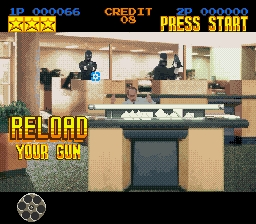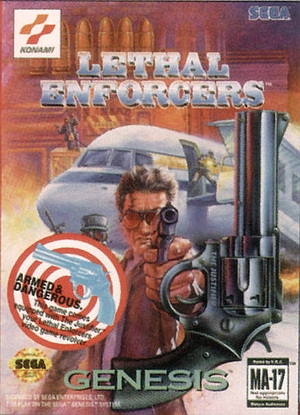
The first time I encountered those twin blue and pink light guns, I was eight years old. The new school year had started, Sonic 2 was glued in the port of my shiny new Sega Genesis, and my parents and I were visiting some family friends. I honestly don’t remember who they were, but I would thank them if I could, because we somehow came home with their copy of Lethal Enforcers, complete with the famous Konami Justifiers. These oversized revolvers dwarfed the Nintendo Zapper both in size and coolness. Whether by gift or by accident, these half-remembered friends never saw the game again.
I got my Genesis in 1994, and Lethal Enforcers, a 1992 release, would start a train of games borrowed and never returned, mostly because the owners grew out of the system before they ever noticed the game was gone. I can’t say I feel bad with a permanently borrowed Ecco the Dolphin 2 and Sonic and Knuckles sitting on my shelf now (I asked most of the owners later if they wanted them back… when I was 23).
 The first in a series of two arcade shooters, Lethal Enforcers’ graphical style was photorealistic and gritty. It felt like being put behind the gun in Lethal Weapon. You didn’t just watch Martin Riggs mow down dozens of crack dealers, you lived it. It caused some controversy when it came out in arcades, depicting violence through actual digitized photographs. However, my family missed the controversy by a few years—and with a police officer and action movie fanatic as head of household, the game quickly became a fixture in our house.
The first in a series of two arcade shooters, Lethal Enforcers’ graphical style was photorealistic and gritty. It felt like being put behind the gun in Lethal Weapon. You didn’t just watch Martin Riggs mow down dozens of crack dealers, you lived it. It caused some controversy when it came out in arcades, depicting violence through actual digitized photographs. However, my family missed the controversy by a few years—and with a police officer and action movie fanatic as head of household, the game quickly became a fixture in our house.
It was one of my first experiences with multiplayer gaming. Ours was a Sega household, and I had not yet made friends with any Street Fighter-savvy SNES kids. As such, I usually played Sonic 2, as well as whatever I could find at the local video rental store. Already a huge fan of cop movies because of my father, I played the new game obsessively, and bothered anyone I could find to play it with me. This only amounted to about three people, but still. I always imagined it as a buddy cop film—I knew I needed a partner for the experience to really be complete.
Soon I was racking up mediocre scores that came dangerously close to the final three letter codename on the high score list, and when I wasn’t playing with my Dad or my best friend from grade school, I kept the pink gun plugged in through its weird phone jack hookup, doubling my shooting power without any extra spent quarters.
Lethal Enforcers was part of a weird breed of light gun shooters that occupied a short time in history. History rapidly moved on from games based on the shooting gallery format (Duck Hunt) to rail shooters (Area 51 and Time Crisis). Eventually, true first-person shooters, like Doom and Duke Nukem, ditched the light guns and lead to the free-roaming, 3D-modeled first person shooters we know today. They were hard as nails, like most arcade conversions of the time. The industry hadn’t yet discovered infinite continues like the console releases of the Metal Slug series eventually did. What made Lethal Enforcers different was its subject matter.
It looked and felt like a buddy cop film, banter and bullets supplied entirely by the player. At the end of the first level, on the third board, Lethal Enforcers left behind the shooting gallery format, and put the player in a car chase, shooting down enemies in moving cars, eventually flowing into a battle with a rocket launcher-wielding bank-robber. Eight-year-old me immediately felt like an action hero, and it was addicting.
 I still pull it out from time to time, and have a go with my friends—although I rarely make it past the second board in level 2, set in Chinatown, Chicago. The throng of Triad gangsters chucking throwing knives always proves too much, but the Big Trouble in Little China vibe makes it my favorite level.
I still pull it out from time to time, and have a go with my friends—although I rarely make it past the second board in level 2, set in Chinatown, Chicago. The throng of Triad gangsters chucking throwing knives always proves too much, but the Big Trouble in Little China vibe makes it my favorite level.
These days, the first person shooter is under scrutiny by many gamers. With yet another military shooter released ever four months, the genre seems to have stalled. There are indeed gems amongst the blandness—the Borderlands series for its style and RPG elements, and Bad Company with its humor and interesting characters—but in my mind, the FPS genre has lost its novelty.
Players in 19XX had a few more choices in the proto-FPS market. We shot ducks, aliens, zombies, criminals, time-bandits, and more. That isn’t to say that these options aren’t still open, and there are indeed different genres to choose from, but the modern FPS fixates almost entirely on the military. Sure, there were military shooters back in the day, like Wolfenstein 3D, but even then, enemies like Mecha-Hitler made the genre wackier than what we have today. This is not to say military shooters are categorically terrible. In fact, most of them are decently polished games—but I am adrift in an ocean of sameness. As I float, I often feel the urge to put down the assault rifle, pick up my old blue six-shooter, and tell some bad guy “your diplomatic immunity’s just been revoked.”
And then shoot them in the face.







